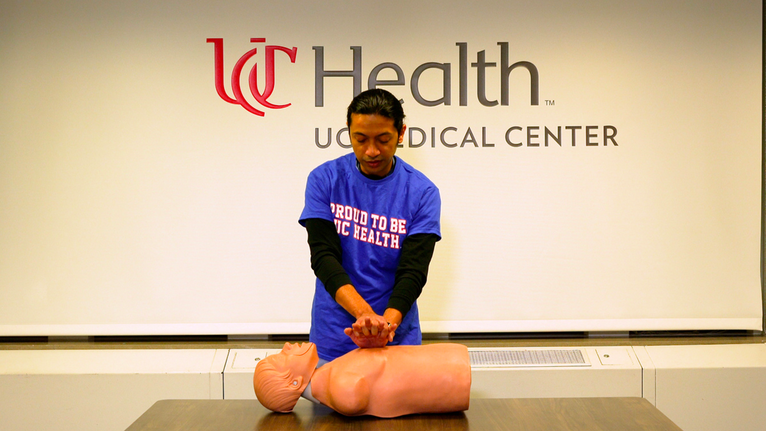“The City of Cincinnati responds to more than 400 cardiac arrests a year,” Jason McMullan, MD, emergency medicine physician at UC Health and associate medical director for the Cincinnati Fire Department said. “Even in the best EMS systems, it takes 4 to 5 minutes from the time a caller makes the call to 911 until the time a responder gets to the scene. For every minute of inaction, the chances of survival go down by 10%. If we can get any bystander to be an immediate responder and do compression-only CPR, the chances of survival can triple.”
Many people don’t believe they are equipped to perform CPR or offer other forms of aid, but knowing some simple steps can help you feel more prepared to help.
Quick Facts on Performing CPR:
- You don’t have to know everything—911 dispatchers can walk you through the steps to take over the phone when someone is unresponsive and needs CPR. Call 911 and put your phone on speaker mode.
- Start compression-only CPR immediately if someone near you is unconscious/unresponsive and not breathing normally to help restart blood and oxygen circulation.
- Anyone can perform hands-only CPR—no formal training is needed. Put your hands in the center of the person’s chest, lean over them and lock your elbows and arms straight. Push down firm and fast to the beat of the Bee Gee’s “Stayin’ Alive” or the toddler favorite “Baby Shark.”
- Keep going until first responders arrive and can take over. If someone else is around, send them to look for an automated external defibrillator (AED).
Why is CPR Important?
CPR can save lives.
As a first-line response that can help save someone’s life in an emergency, this technique aims to keep oxygen moving to vital organs, especially the brain, until the heart can beat on its own again.
The Best Response to Cardiac Arrest
When someone is suffering a sudden cardiac arrest, CPR before professional help arrives gives the best chance of survival. By some estimates, performing CPR immediately can double or triple the chance of survival from a sudden cardiac arrest that occurs outside of a hospital. A patient's chances of recovery, and avoiding brain death, rely on immediate CPR—this makes understanding the fundamentals of CPR the difference between life and death.
When is it Necessary to Perform CPR?
Check the following:
- Is the person unconscious and/or unresponsive?
- Has the person stopped breathing normally?
If the answer to these questions is yes, call 911, put your phone on speaker call and begin compression-only CPR right away.
Hands-only CPR
For those untrained or uncertified in standard CPR, hands-only CPR using chest compressions is a simple and effective alternative.
To perform hands-only CPR:
- Place your hands in the center of the person’s chest between their nipples, lean over them, lock your elbows and wrists straight and press firmly.
- Pump to the rhythm of a familiar song like “Stayin’ Alive” or “Baby Shark”, which will help guide you in frequency of the compressions.
- Perform 100-120 chest compressions per minute without stopping until further help arrives or breathing/pulse are restored.
Helping with First Aid
CPR is a form of first aid that applies under certain conditions like a sudden cardiac arrest, which includes loss of pulse. First aid helps give the person experiencing a medical emergency the best chance of survival until medical professionals arrive on the scene.
It’s important to give first aid for many types of injuries as a first line of action before seeking professional help. Doing so can help minimize the pain and impact of the injury, as well as prevent further damage or more serious issues.
Every injury is different, but you can be prepared to provide general first aid with the following steps in mind:
- Ensure the situation is safe for you before approaching an injured person.
- Note if the person is conscious and breathing, as well as if they can move, speak, or if they show other signs that help you assess the severity of the injury.
- Call 911 if necessary.

